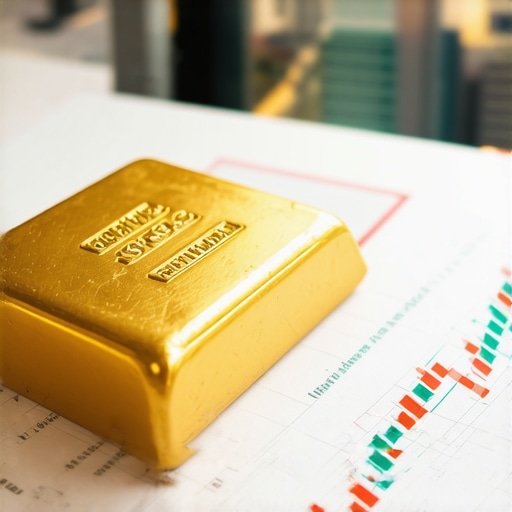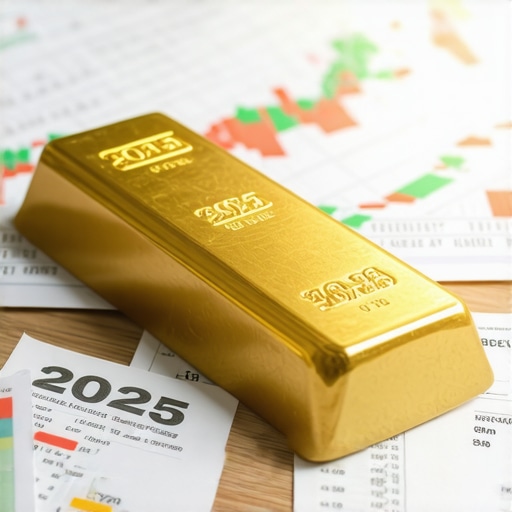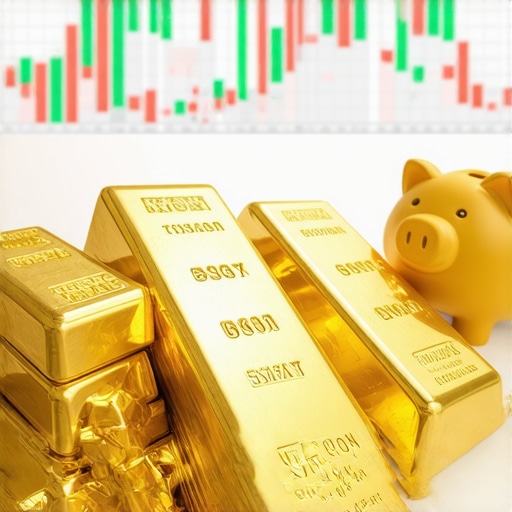Unlocking the Potential of Gold ETFs: A Deep Dive for 2025 Investors
In the evolving landscape of financial markets, gold exchange-traded funds (ETFs) have become a pivotal component for sophisticated investors seeking portfolio diversification and inflation hedging. As we approach 2025, the strategic selection of the best gold ETF demands an expert understanding of market dynamics, supply-demand fundamentals, and the nuanced differences among available products.
Understanding the Core Mechanics of Gold ETFs in the Context of 2025 Market Drivers
Gold ETFs function as liquid proxies for physical gold, providing investors exposure without the complexities of storage. The effectiveness of a specific ETF hinges on factors such as expense ratios, tracking accuracy, and underlying asset liquidity. Notably, in 2025, macroeconomic indicators like inflation trajectories, central bank policies, and geopolitical tensions significantly influence gold’s market performance, which in turn impacts ETF returns.
What Are the Key Differentiators Among Leading Gold ETFs in 2025?
Among the top contenders, ETFs such as SPDR Gold Shares (GLD) and iShares Gold Trust (IAU) stand out due to their liquidity and low expense ratios. However, emerging ETFs with niche strategies or innovative structures may offer unique benefits, such as enhanced tracking or tax efficiency. Evaluating these differences requires rigorous analysis of fund prospectuses, liquidity metrics, and historical tracking error, especially in the context of volatile macroeconomic conditions.
Expert Strategies for Optimizing Gold ETF Investments in 2025
To maximize returns, investors should consider a layered approach: incorporating technical analysis to time entry points, analyzing supply-demand metrics from industry reports, and assessing macroeconomic indicators. Additionally, diversification within gold-related assets, such as gold mining stocks and physical bullion, can complement ETF positions and mitigate systemic risks.
How Does Gold Demand from Industry and Central Banks Influence ETF Performance?
Gold’s price drivers are intricately linked to demand from jewelry, technology, and central bank purchases. For instance, increased central bank gold accumulation, as documented by the World Gold Council, can signal institutional confidence and tend to bolster ETF prices. Understanding these supply-demand dynamics provides a strategic edge in selecting ETFs that best leverage these macro trends.
What Are the Risks of Relying Solely on Gold ETFs in a Diversified Portfolio?
While gold ETFs offer liquidity and ease of access, they are subject to market risks, tracking errors, and potential regulatory shifts. Overconcentration in gold assets may also expose portfolios to sector-specific volatility, underscoring the importance of a balanced asset allocation strategy.
For a comprehensive guide on integrating gold ETFs into your 2025 investment strategy, explore our strategies for buying gold safely in 2025. Staying informed through expert analysis and industry insights ensures your portfolio remains resilient amid market fluctuations.
As the gold market continues to evolve, consulting trusted sources like the World Gold Council can provide valuable data to inform your ETF selection process.
Exploring Advanced Metrics: How Do Gold ETF Tracking Errors Impact Portfolio Returns in 2025?
While low expense ratios often attract investors, the significance of tracking error cannot be overstated. Tracking error measures the deviation of an ETF’s performance from its underlying gold price. In volatile markets of 2025, even minor discrepancies can lead to substantial deviations in expected gains or losses. Analyzing historical tracking data, as highlighted by industry reports like those from gold market analysis, helps investors select ETFs with minimal tracking errors, ensuring their portfolio aligns closely with gold’s market movements.
How Can Investors Leverage Macro-Economic Indicators to Time Gold ETF Entries?
Macro-economic indicators such as inflation rates, interest rate policies, and geopolitical tensions serve as critical signals for timing entry and exit points in gold ETFs. For example, rising inflation often prompts increased gold demand, pushing ETF prices upward. Conversely, rate hikes by central banks can suppress gold prices temporarily. An expert approach involves integrating technical analysis with macroeconomic data—systems like those described in market timing techniques—to optimize investment timing and maximize gains in 2025.
Are Gold ETFs Truly a Hedge Against Market Turmoil, or Are There Hidden Risks?
Gold ETFs are often heralded as safe havens during economic or geopolitical crises. However, relying solely on ETFs can introduce risks such as liquidity constraints during extreme volatility or regulatory changes affecting ETF structures. Moreover, ETFs are susceptible to market sentiment shifts, which might diverge from physical gold prices in the short term. A balanced approach involves combining ETFs with physical gold holdings and gold mining stocks, aligning with diversified strategies detailed in diversification strategies. This multi-faceted approach ensures resilience, especially when macroeconomic uncertainties intensify in 2025.
If you’re interested in refining your gold investment tactics, check out our comprehensive strategies for buying gold safely in 2025. Staying informed with industry insights and expert analyses is crucial for navigating market complexities and safeguarding your wealth.
For authoritative insights, consulting resources like the World Gold Council remains invaluable, providing data-driven perspectives on global gold demand and supply dynamics that influence ETF performance in 2025.
Deciphering the Impact of Global Monetary Policies on Gold ETF Valuations in 2025
As the global economy navigates uncharted waters, central banks’ monetary policies have emerged as pivotal drivers of gold ETF performance. With interest rates, quantitative easing, and tapering measures fluctuating in response to inflationary pressures and economic recovery trajectories, understanding their nuanced effects becomes essential for sophisticated investors. For instance, as highlighted by the International Monetary Fund (IMF) in their 2024 World Economic Outlook, accommodative policies tend to weaken fiat currencies, thereby bolstering gold demand and ETF valuations. Conversely, tightening policies can induce short-term declines, even amidst underlying bullish fundamentals.
How Do Currency Fluctuations and USD Dynamics Influence Gold ETF Prices?
Gold, priced predominantly in US dollars, exhibits a strong inverse relationship with the greenback’s strength. A weakening dollar makes gold more affordable for international investors, elevating demand and consequently ETF prices. In 2025, with the dollar experiencing volatility driven by geopolitical tensions and divergent monetary policies among major economies, tracking currency trends becomes paramount. Experts recommend integrating FX hedging strategies within gold ETF portfolios to mitigate adverse currency impacts, as detailed in the comprehensive analysis by the IMF’s World Economic Outlook.
What are the sophisticated methods to quantify tracking error and its implications during high volatility?
Quantifying tracking error involves statistical measures like standard deviation of the difference between ETF returns and the underlying gold price. During periods of high volatility—such as geopolitical crises or macroeconomic shocks—tracking errors can widen, leading to discrepancies that erode expected gains. Advanced models, including Jensen’s alpha and Beta analysis, provide deeper insights into an ETF’s tracking efficiency, enabling investors to select funds with minimal deviation even amid turbulent markets. Industry reports from gold market analysis emphasize the importance of such metrics for strategic allocation.
Integrating Machine Learning for Predictive Gold ETF Trading in 2025
Emerging technologies like machine learning and AI-driven analytics are revolutionizing gold ETF trading strategies. By analyzing vast datasets—ranging from macroeconomic indicators to sentiment analysis of geopolitical news—these tools can forecast short-term price movements with increasing accuracy. For example, predictive models leveraging neural networks can identify subtle market signals often invisible to traditional analysis. Financial firms and hedge funds are increasingly adopting these methods, as documented in the recent research by CFA Institute. Investors seeking a competitive edge should consider incorporating such AI-based tools into their decision-making frameworks.
What Are the Risks of Over-Reliance on Quantitative Models in Gold ETF Investment?
While quantitative models offer precision, they are not infallible. Over-reliance can lead to systemic risks, especially if models fail to adapt to unforeseen market shocks or black swan events. Moreover, models trained on historical data may not fully capture evolving macroeconomic paradigms, leading to model risk. To mitigate these pitfalls, diversification across multiple analytical approaches—including fundamental analysis, sentiment tracking, and macroeconomic review—is crucial. As noted by the CFA Institute, combining quantitative rigor with qualitative judgment enhances resilience and adaptability in complex markets.
For investors eager to deepen their understanding of advanced gold ETF strategies, exploring authoritative resources like the World Gold Council can provide invaluable insights into global demand trends and supply fundamentals shaping the market in 2025.
Decoding the Influence of Global Geopolitical Shifts on Gold ETF Dynamics in 2025
Geopolitical tensions, trade disputes, and regional conflicts remain key catalysts affecting gold prices and, consequently, ETF valuations. In 2025, the geopolitical landscape is marked by emerging flashpoints and evolving alliances, which can cause sudden market volatility. Sophisticated investors monitor geopolitical risk indices and diplomatic developments, integrating these insights into their asset allocation models. Understanding the nuanced impact of geopolitical events on gold demand—particularly in regions with significant gold consumption—enables more precise ETF positioning and risk management.
How Can Sentiment Analysis and Alternative Data Enhance Gold ETF Trading in 2025?
In the era of big data, leveraging sentiment analysis derived from news feeds, social media, and geopolitical reports offers a competitive edge. Advanced algorithms parse vast datasets to detect subtle shifts in market sentiment that precede price movements. For instance, spikes in negative sentiment related to monetary policy or inflation fears can signal upcoming increases in gold ETF prices. Integrating alternative data sources—such as shipping freight rates or commodity inventories—further refines predictive models, empowering investors to anticipate market turns with greater accuracy.
What Are the Cutting-Edge Techniques for Minimizing Tracking Error During Market Turmoil?
Minimizing tracking error in volatile environments requires employing sophisticated quantitative techniques, including dynamic replication strategies and real-time portfolio rebalancing. Techniques like error-correction models and machine learning algorithms adapt quickly to market disruptions, maintaining close alignment with gold prices. Industry leaders recommend utilizing high-frequency data and adaptive hedge ratios to mitigate tracking deviations, especially in turbulent periods characteristic of 2025’s geopolitical and macroeconomic landscape.
The Role of ESG Factors in Shaping Gold ETF Investment Decisions in 2025
Environmental, Social, and Governance (ESG) considerations have gained prominence, influencing investor preferences and ETF offerings. Gold mining companies, and thus gold-backed ETFs, are increasingly evaluated based on sustainability practices, carbon footprint, and social responsibility. Incorporating ESG metrics into ETF selection criteria aligns portfolios with ethical standards while potentially enhancing long-term returns. Resources like the World Gold Council provide comprehensive ESG reports, guiding investors toward responsible investment choices amid evolving regulatory landscapes.
Leveraging Machine Learning for Adaptive Gold Market Predictions in 2025
Machine learning models, including reinforcement learning and neural networks, are revolutionizing market forecasting. These tools process multifaceted data streams—covering macroeconomic indicators, geopolitical events, and market sentiment—to generate adaptive trading signals. In 2025, deploying such models enables traders to anticipate short-term price swings and optimize entry/exit timing for gold ETFs. Leading hedge funds are investing heavily in AI-driven analytics, making mastery of these techniques a key differentiator for discerning investors.
How Do Regulatory Changes Impact Gold ETF Structures and Investor Strategies?
Regulatory shifts—such as tax reforms, transparency requirements, and market oversight—can substantially influence ETF liquidity, cost structures, and investor access. Staying ahead of regulatory developments through dedicated compliance and legal analysis ensures that ETF strategies remain resilient. For example, recent proposals to enhance ETF transparency could alter liquidity dynamics, necessitating adjustments in portfolio management approaches. Engaging with industry experts and legal advisors is essential to navigate this complex regulatory environment effectively.
To stay at the forefront of gold investment innovation, explore our comprehensive strategies for buying gold safely in 2025. Harnessing these advanced insights will empower you to make informed, resilient investment decisions amid the multifaceted landscape of 2025’s gold market.
For authoritative, data-driven perspectives on global gold demand and supply fundamentals, consult the World Gold Council. Their extensive research provides vital context for refining your ETF investment strategies in the evolving economic environment of 2025.
Expert Insights & Advanced Considerations
1. Dynamic Asset Allocation is Key: Emphasize the importance of regularly adjusting your gold ETF holdings based on macroeconomic shifts, geopolitical developments, and currency trends. Staying agile ensures you capitalize on emerging opportunities and mitigate risks.
In 2025, the landscape demands active management of gold ETF investments, leveraging real-time data and predictive analytics to optimize portfolio resilience and growth.
2. Integrate Cutting-Edge Technology: Utilize machine learning models and AI-driven market analysis to forecast short-term price movements, enabling more precise entry and exit points in your gold ETF strategy.
Advanced technological tools are transforming investment precision, allowing sophisticated investors to stay ahead of market volatility and macroeconomic surprises.
3. Focus on ESG-Integrated Gold ETFs: Prioritize ETFs that incorporate environmental, social, and governance factors, aligning your portfolio with sustainability trends that are increasingly influencing investor behavior in 2025.
Responsible investing through ESG criteria not only supports ethical standards but can also enhance long-term returns, reflecting the evolving preferences of global investors.
4. Master the Art of Tracking Error Management: Employ high-frequency data analysis and adaptive hedging techniques to minimize tracking errors during periods of heightened market turbulence.
Reducing tracking error is critical in volatile environments, ensuring your ETF performance remains closely aligned with physical gold prices and macroeconomic fundamentals.
5. Diversify with Complementary Gold Assets: Combine ETFs with physical gold holdings, gold mining stocks, and industry-specific funds to build a resilient, diversified portfolio that withstands macroeconomic shocks.
This multi-faceted approach enhances risk mitigation and captures various growth drivers within the gold market ecosystem.
Curated Expert Resources
- World Gold Council: The definitive resource for comprehensive data on global gold demand, supply, and ESG trends, essential for strategic decision-making.
- IMF World Economic Outlook: Provides macroeconomic insights and monetary policy updates vital for timing and positioning in gold ETFs.
- CFA Institute Research: Offers cutting-edge analyses on quantitative models, market sentiment, and risk management techniques applicable to gold ETFs.
- Gold Market Analysis Reports: Industry-leading reports with real-time data on supply-demand dynamics, tracking error metrics, and geopolitical risk assessments.
- AI and Machine Learning in Finance Journals: Latest research on integrating AI tools into investment strategies, including predictive modeling for gold prices.
Final Expert Perspective
As we navigate 2025, mastering the intricacies of gold ETF investment requires a synthesis of macroeconomic awareness, technological innovation, and disciplined risk management. The most impactful insight is that dynamic asset management—fueled by advanced analytics and responsible investing—will define the success of your portfolio. Engage with authoritative resources like the World Gold Council and continuously refine your strategies through cutting-edge research and real-time data integration. For those committed to excellence in gold investing, embracing these expert insights will position you at the forefront of market developments and safeguard your wealth against future uncertainties. Explore our detailed guides on buying gold safely in 2025 and stay informed to make impactful decisions.










